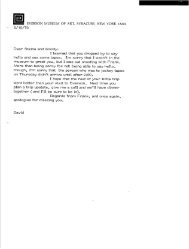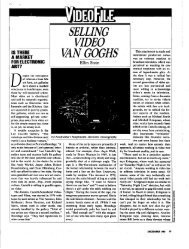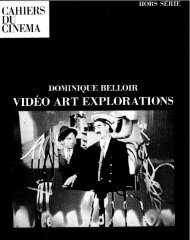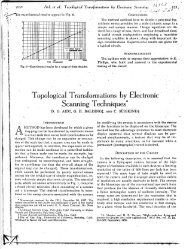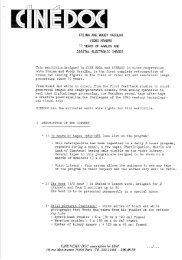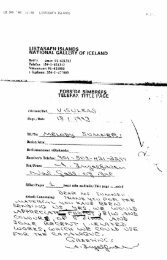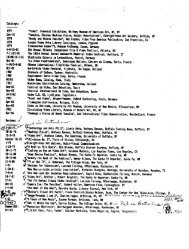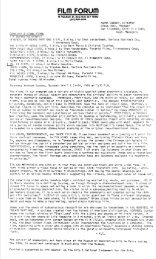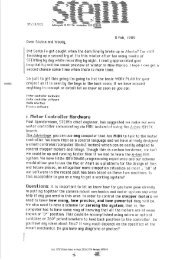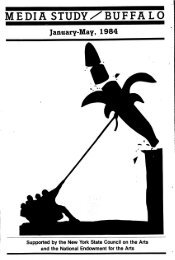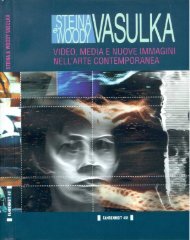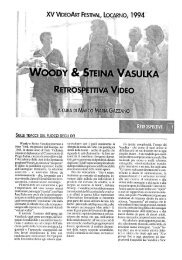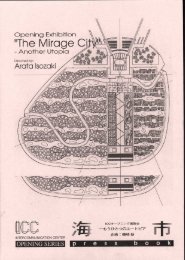Chapter 4: A HISTORY OF COMPUTER ANIMATION ... - Vasulka.org
Chapter 4: A HISTORY OF COMPUTER ANIMATION ... - Vasulka.org
Chapter 4: A HISTORY OF COMPUTER ANIMATION ... - Vasulka.org
Create successful ePaper yourself
Turn your PDF publications into a flip-book with our unique Google optimized e-Paper software.
<strong>Chapter</strong> 4: A <strong>HISTORY</strong> <strong>OF</strong> <strong>COMPUTER</strong> <strong>ANIMATION</strong> 3/20/92 4<br />
advanced their chalk-on-a-blackboard drawings, as in Humorous<br />
Phases of Funny Face (1907) (fig . 6) .<br />
The technique of single frame recording individual and<br />
successive ink-on-paper drawings (fig . 8) was pioneered by two<br />
newspaper cartoonists who f<strong>org</strong>ed a relationship between the daily<br />
newspaper and the cinema : Emile Cohl in France (1908) and Windsor<br />
McCay in New York (1911) . The longer running times of roll media<br />
removed the constraint of drawing only cycles ; action could<br />
commence and continue without returning to its origin . Thus<br />
animation evolved from the concept of a phase picture to the concept<br />
of a shot, a contiguous piece of action .<br />
Another special effect was the multiple exposure, pioneered<br />
by Melies (1902) and others, which involved exposing, rewinding, and<br />
then reexposing a single strand of film emulsion . The multiple<br />
exposures could superimpose images, create dissolves, and let<br />
Melies act with himself on the screen . Edwin Porter combined<br />
multiple exposures with mattes to capture a moving exterior<br />
outside the window of the station house in The Great Train Robbery<br />
(1903) . Worked with a twist, multiple exposures may also be used<br />
to combine animation with live action, as in Edison's Enchanted<br />
Drawing (1900), which incorporated blackboard chalk scratchons and<br />
an actor (fig . 11), possibly shot with a split screen technique .<br />
Remember that in these days before optical printers or video<br />
compositers the entire image had to be exposed into one original<br />
camera negative . Reverse action, action that is running<br />
backwards, was discovered in 1903 .<br />
But it is worth observing that the purpose of the special effect<br />
was viewed quite differently by early directors : For Melies the<br />
6 . Scratchon . Single frame photography of progressive<br />
blackboard scratchon drawing is technique used to make J . Stuart<br />
Blackton's Humorous Phases of Funny Face in 1907 . [locate and<br />
permission]<br />
8 . Single frame photography of successive paper drawings breaks<br />
away from cyclic phase drawing and is a pathway to the cel system .<br />
In Windsor McCay's Gertie the Trained Dinosaur the entire drawing is<br />
recreated for each frame .<br />
11 . Split reel technique was probably used in this 1900 short<br />
produced by the Edison Company called The Enchanted Drawing . In<br />
the action an artist sketches the face of a sad tramp on a paper pad .<br />
Next he draws a cigar and the tramp begins to puff large clouds of<br />
smoke as the actor leaps back in astonishment . [locate and<br />
permission eg in Madsen]



